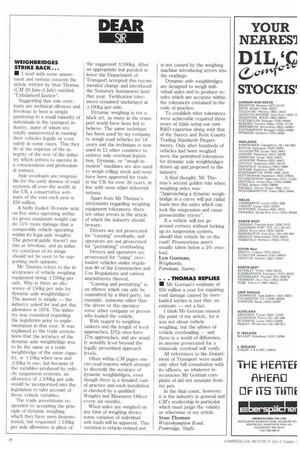WEIGHBRIDGES STRIKE BACK...
Page 28

If you've noticed an error in this article please click here to report it so we can fix it.
• 1 read with sonic amazement and serious concern the article written by Stan Thomas (CM 29 June-5 July) entitled, "Unbalanced Justice", Suggesting that axle overloads are technical offences and frivolous to boot is simply pandering to a small minority of individuals in the transport industry, many of whom are totally uninterested in running their vehicles legally or even safely in some cases. This they do at the expense of the integrity of the rest of the industry which strives to operate in a conscientious and professional manner.
Axle overloads are responsible for the early demise of road systems all over the world: in the UK a conservative estimate of the cost each year is 250 million.
A badly loaded 38-tonne artic on five axles operating within its gross maximum weight can do 15% more damage than a comparable vehicle operating within its legal axle weights. The general public doesn't see this as frivolous, and an industry conscious of its image should not be seen to be supporting such opinions.
Mr Thomas refers to the inaccuracies of vehicle weighing equipment being ±150kg per axle. Why is there an allowance of 150kg per axle for dynamic axle weighbridges? The answer is simple — the industry asked for and got this allowance in 1978. The industry was consulted regarding the legislation prior to implementation in that year. It was explained to the trade associations that the accuracy of the dynamic axle weighbridge was to be the same as a trade weighbridge of the same capacity, ie ±10kg when new and ±20kg in use, but because of the variables produced by vehicle suspension systems, an allowance of ±100kg per axle would be incorporated into the legislation to take account of these vehicle variables.
The trade associations responded by accepting the principle of dynamic weighing which they have seen demonstrated, but requested ±150kg per axle allowance in place of the suggested ±100kg. After an appropriate but puzzled silence the Department of Transport accepted this recommended change and introduced the Statutory Instrument later that year. Verification tolerances remained unchanged at ±100kg per axle.
Dynamic weighing is not a black art, as many in the transport world have been led to believe. The same technique has been used by my company to weigh road vehicles for 18 years and the technique is now used in 12 other countries to enforce axle overload legislation. Dynamic, or "weigh-inmotion" machines are also used to weigh rolling stock and most have been approved for trade in the UK for over 20 years, in line with most other industrial nations.
Apart from Mr Thomas's statements regarding weighing equipment tolerances, there are other errors in the article of which the industry should beware.
Drivers are not prosecuted for "causing" overloads, and operators are not prosecuted for "permitting" overloading.
Drivers and operators are prosecuted for "using" overloaded vehicles under regulation 80 of the Construction and Use Regulations and various amendments thereof.
"Causing and permitting" is an offence which can only be committed by a third party, for example, someone other than the driver or the operator: some other company or person who loaded the vehicle.
With regard to weighing tankers and the length of level approaches, DTp sites have 17m approaches, and are usually sensibly level beyond the legally prescribed approach levels.
Often within CM pages one can read reports which attempt to discredit the accuracy of dynamic weighbridges, even though there is a detailed code of practice and each installation is checked by a qualified Weights and Measures Officer every six months.
When axles are weighed on any kind of weighing device some variation of individual axle loads will be apparent. This variation is vehicle-related and is not caused by the weighing machine introducing errors into the readings.
Dynamic axle weighbridges are designed to weigh individual axles and to produce results which are accurate within the tolerances contained in the code of practice.
To establish what tolerances were achievable required three years of trials using our own R&D expertise along with that of the Surrey and Kent County Trading Standards Departments. Only after hundreds of vehicles had been weighed were the permitted tolerances for dynamic axle weighbridges drawn up and proposed to the industry.
A final thought: Mr Thomas's second golden rule when weighing axles was: "Approaching a dynamic weighbridge in a curve will put radial loads into the axles which can lock the suspension and cause prosecutable errors".
If a vehicle will not go around corners without locking up its suspension system, should that vehicle be on the road? Prosecutions aren't usually taken below a 5% overload.
Len Gorman, Weighwrite, Farnham, Surrey.




































































































































